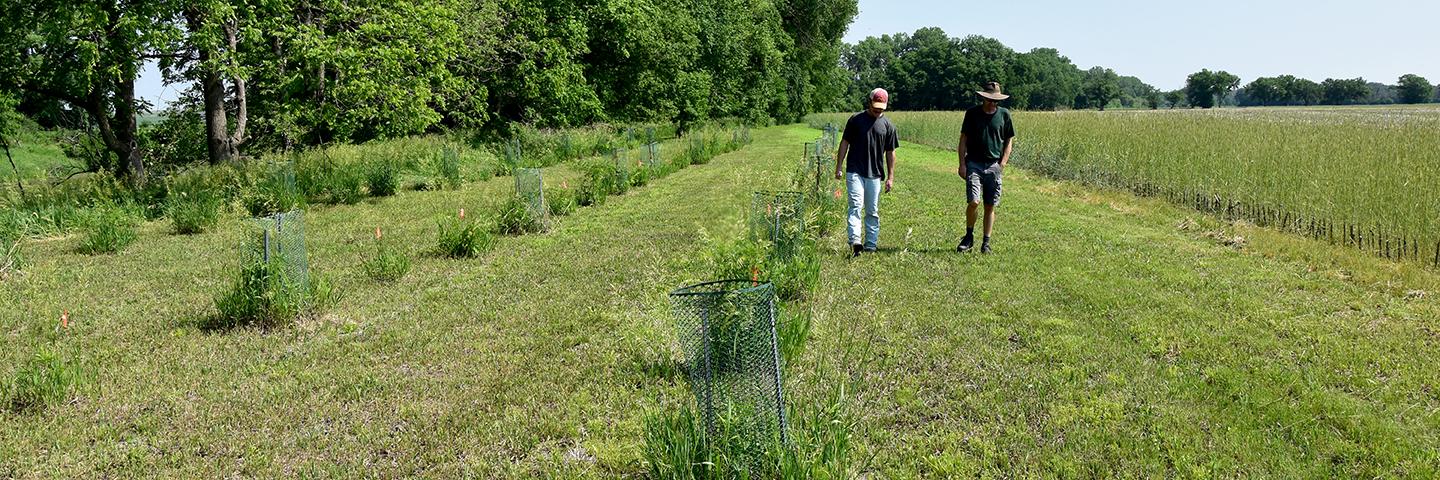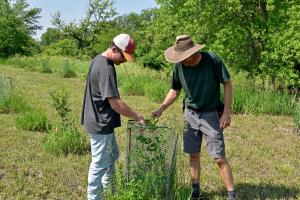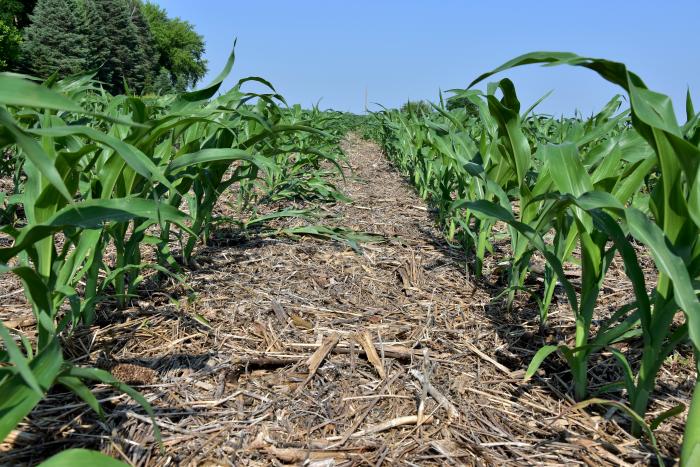Wildlife Practices Go 'Hand in Hand' with Soil Health

Maple Edge Farm in Mills County is turning over a new leaf with the addition of about 150 trees and shrubs and many other wildlife-friendly practices planned on the Century Farm that sits along the West Nishnabotna River just north of Hastings, Iowa.
Led by fifth generation operator Jon Bakehouse, the family farm may be best known in the area for its innovative soil health practices, but soon it will be home to more tree, shrub and pollinator plantings across the 750-acre farm.
Bakehouse, who farms with his father, Bach, and his sister, Jeanne-Marie, says flora and fauna go hand in hand with his soil health projects. “With the tree and shrub plantings, you think of flowers and animals, but it’s also the below ground impacts – like all the nematodes, worms, and arthropods, and all that good stuff,” he said.
“The tree and shrub planting has been awesome,” said Bakehouse. “I’m trying to get some of that mosaic reestablished – to get back to what made Iowa prairie so resilient.”
Wildlife Enhancements Through CSP

The Bakehouse family is utilizing funds offered through USDA’s Conservation Stewardship Program (CSP) to implement several wildlife-friendly activities on their land. “We chose some of these practices because we need more habitat on the farm,” he said. “We hadn’t done a lot of that before and the practices we chose will be manageable.”
The new planting includes oak and walnut trees, along with fruit bearing shrubs like ninebark and chokecherry.
Last winter, Bakehouse seeded a nearly three-acre, eastern gamagrass pasture planting. He said the Iowa Soybean Association conducted a survey on the farm to suggest alternatives to crop production. “One of the suggestions was to plant gamagrass in wet areas where we couldn’t raise much else,” said Bakehouse. “I really like the perennial aspect of the pasture.”
He also spoke with Dale Strickler – a Kansas author and consultant on managing pasture. “We had an amazing, invigorating conservation about it, so we decided to try it,” said Bakehouse.
Led by USDA’s Natural Resources Conservation Service (NRCS), CSP offers payments for maintaining the existing level of conservation and pays producers for implementing additional conservation activities. Contracts run five years, with the opportunity to compete for a contract renewal with successful fulfillment of the initial contract.
“The NRCS has been so good to work with. They make it easy,” said Bakehouse. “Some people are distrustful of government or whatever, but I don’t feel that way. These guys have been really helpful.”
Bakehouse is scheduled to add several other CSP conservation enhancements to his farm over the next few years. He will plant 1.5 acres of additional trees and shrubs, seed a small area for conservation cover to benefit pollinators and beneficial insects, and implement 10 acres of prescribed grazing which includes a small rotational grazing system for his 20 cow-calf pairs.
He has also planted about 10 acres of prairie strips, working with Iowa State University and Golden Hills Resource Conservation & Development (RC&D) as part of a West Nishnabotna Watershed project.
“Jon has taken a leadership role in this area of the state,” said Andrew Welch, District Conservationist in Malvern for NRCS. “He is involved in many organizations and is conducting on-farm research projects with Practical Farmers of Iowa (PFI), for example, to improve his operation and to help other local farmers.”
Ag Land Projects
Currently, Bakehouse is researching reduced nitrogen applications on corn and using a roller crimper to terminate cereal rye before soybeans. “I am super jazzed about where the roller crimper could possibly lead for our cropland,” he said, “but the learning curve on it is steep!”

The Bakehouses, who farm about 600 cropland acres, purchased the roller crimper a few years ago when herbicide prices went up. Jon says roller crimping cereal rye means planting soybeans 2-3 weeks later than normal to allow for the rye to mature before crimping. “There’s a tradeoff, but when you’re talking about soil health, water infiltration, and the soil armor properties of that rye lying flat on the surface, you can’t beat it,” said Jon.
Maple Edge Farm is in the lowest spot for miles around. “We are in a bowl where all water ends up,” he said. “When my grandfather farmed this ground, the goal was to get rid of water. He spent decades putting in surface ditches. We haven’t installed any drainage tile. We try to maintain the surface water ditches and increase the water holding capacity of our soils.”
After discing for many years to loosen the soil, Jon learned it was actually causing a compaction layer 2-3 inches below the soil surface. “One day I saw a guy talking about the impact of discing and it’s basically a tool creating a compaction layer – same as plowing or deep tillage,” said Bakehouse. “I thought that was interesting, so I tried no-till.”
No-till helped improve water infiltration almost immediately, and Bakehouse says the increase in organic matter was an unexpected benefit. Then, after several years, he says things plateaued.
That’s when he started experimenting with cereal rye. “With cover crops, we are seeing even more water infiltration and soil health improvements,” said Bakehouse.
Now, we are focused on the quality of water leaving our farm, he said. “How do we slow down the water leaving our farm? How does our little ecosystem here fit into the larger ecosystem, especially when it comes to trees and shrubs, prairie strips, and other little areas of native prairie?” he asked.
“If you’re not concerned about the quality of the water leaving your farm, what difference does it make if you’re growing 100-bushel soybeans and 300-bushel corn,” said Bakehouse. “Same with soil erosion – if you’re blowing soil into your neighbor’s windows or across the interstate, what’s the point?”
For more information about conservation practices and programs to help treat natural resource concerns on your land, visit your local NRCS office or go to www.nrcs.usda.gov/ia.

